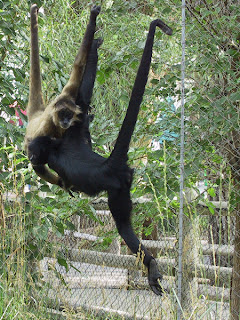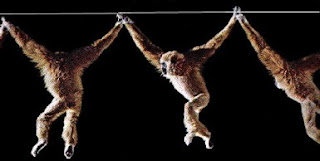Lemurs:
(a) There is a variety of Lemurs that
live in many different areas of madagascar. However, the common
thread amongst all of their habitats is trees. Madagascar is a
beautiful island covered in forests and seasonal vegetation.
(b) The locomotor patterns of Lemurs,
are just a varied as their habitat. Some swim, some leap and some
move fast while others move slowly. For the most part however, they
can be divided between 2 categories; vertical clingers/leapers and
the aboreal quadrupeds. The leapers possess powerful back legs that
allow them to jump to neighboring trees, landing on their back legs
and clinging with their front paws. The aborreal quadrupeds move on
all fours, some slow in a sloth-like hanging position. Others more
quickly in an upright walking fashion.
(c) This locomotive patter evolution has
been greatly influenced by the Lemur's environment. This is proven by
the fact that each habitat has caused the Lemur to branch off into
different species in the same genus with a variation of locomotive
patters, and supporting limbs.
(d)
Spider Monkey:
(a) Spider Monkeys are found in the
tropical forests of Central and South America. The forests are
comprised of very tall trees. Spider Monkeys live in upper layers of
these trees.
(b) The majority of Spider Monkeys
climb, leap, or fly. Mostly, bipedalism, which means that the primate
only uses two limbs while leaping or swinging. These animals also use
quadrupedal motion while running, meaning that they use all four
limbs. Also, most climbing is suspensory; hanging onto the branch.
(c) The environment influenced this
animals locomotion because of the fact that they live so high in the
trees they must have strong back limbs to leap as well as a long tail
to assist with balance. Their long front limbs and hook-shaped hands,
also help them with hanging and suspending from the branches of the
tall trees. Furthermore, their long tail serves as a fifth limb,
assisting with suspension.
(d)
Baboon:
(a) The Baboon is a primate that lives
in East Africa. They are a greatly adaptable species that can live in
a wide variety of habitats. They are ground dwellers that tend to
sleep in trees or on cliff faces.
(b) The Baboon moves around quadrupedal
on their digits. Meaning that they walk on their toes, not on their
whole foot as humans do.
(c) The quadrupedal locomotor pattern of
the Baboon adapted from their ground habitat. Living in the plateaus
of Eastern Africa allowed them to develop limbs that would allow them
to forage the grounds, as well as climb to higher heights for safety
while sleeping.
(d)
Gibbon:
(a) Gibbons live in the dense areas of
Southeast Asia. Primarily in the trees; they rarely come down to the
ground.
(b) Gibbons are agile and acrobatic.
They move by branchiating, which swinging from branches and vines.
They use four fingers of their hands to hang onto and swing from
branches. They can also leap through the gaps in the trees and walk
on the branches on two feet with their arms in the air for balance.
(c) Being that the Gibbon lives high in
the trees, their long adapted limbs help them soar through the trees.
Also, they've adapted long arms for balance, as well as branchiating.
(d)
Chimpanzee:
(a) Chimpanzees live in rain forests,
both in the trees and on the forest floor.
(b) Chimpanzees move quadrupedally both
on the ground and in the trees. They also branchiate, swing and
cling, in the trees. Chimps are also capable of bipedaling or walking
upright, but only when necessary.
(c) Chimpanzees have adapted to their
environment by developing long arms for branchiating. They've also
developed knuckles that they can use for support. Since their arms
are longer than their legs, they use their knuckles for support when
walking.
(d)
4. Through the comparison of these five primates, it is obvious that environments greatly influence locomotor patterns both physically and behaviorally. In each case study, the different environment influence a different physical trait; longer arms, longer talk, supportive knuckles, etc. Each primate also developed a different way to maneuver it's environment. Those who live higher in the trees developed ways to swing from branches, and ways to keep their balance, like the Gibbon's holding their arms in the air.





Overall, very good post. You addressed all of the key information and your images were great.
ReplyDeleteA couple of points:
You mention that chimps brachiate. They don't! Gibbons are relatively unique with this trait. Orang brachiate a little as do some new world monkeys, but definitely not chimps.
In general, your discussion at the end is good, but why are some primates arboreal and some are terrestrial? What environmental influences lead to one or the other? Is it just one stress or is it multiple?
Other than these point, good post.
Danielle, I found your post very informative and very insightful. The unique locomotor patterns of each primate all somehow relate and their functions are all very similar but each primate use their limbs to each one of their abilities. After studying the dentition patterns of each primate in my blog analysis, It became very apparent that each primates locomotor patterns not only effected their sense of mobility but also their diet and dentition patterns. If it weren’t for their limbs and how they use them each primate wouldn’t have the diet or dentition pattern that they have grown to have because their limbs assist their diet and help cater to their diet according to their genetic makeup. One point that I found particularly interesting is that I did not know lemurs could also swim as well as Gibbons rarely being seen on the ground. I figured that each primate used their long limbs, tails and appendages to move and travel but got a better understanding that their limbs also assisted to their diet after examining your post along with the finding I analyzed in mine. Overall, good job!
ReplyDeleteDanielle, I think your post was very informative. I really like what you said about the Gibbons. The vocabulary you used, "agile and acrobatic" made it as if I could actually see them swinging from tree to tree. I also found it interesting that they adapted to help their balance by ending up with longer arms.
ReplyDeleteGood post. :)
Danielle,
ReplyDeleteI agree with Karleigh, you used great vocab in your post. Even when you're just discussing the facts it was still in an interesting way. I learned a lot from your post even though I researched the same animals you did. All of the different tail lengths compared to how high or low the species will go up into a tree was the most interesting to me. Reading your post made me see the connection. Also the size of the species has a lot to do with it. Overall great post. I learned a lot which was cool.
Thanks
Chelsea Sanders